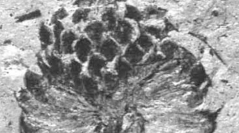

 Comptes Rendus Palevol
4 (6-7) - Pages 637-652
Comptes Rendus Palevol
4 (6-7) - Pages 637-652The biotic recovery that succeeded the end-Permian life crisis event lasted a long period, estimated at ca 8 to 10 Myr, even 14 Myr. It is thought that it essentially proceeded from refugia whose geographic location can never be established. Their existence can nevertheless be inferred from the surprising stability exhibited by some fossil communities between the Late Palaeozoic and the Triassic. It is the case of the biocoenoses from the ‘Grès à Voltzia’ Formation (Upper Buntsandstein) of eastern France, which consist of Palaeozoic survivors (crustaceans, amphibians, insects, plants), taxa that announce the modern faunas (crustaceans, spiders, scorpions, insects), living fossils (lingulids, the panchronic species Triops cancriformis) as well as pioneering species which invaded rapidly the disturbed ecospaces (the herbaceous conifer Aethophyllum). The ‘Grès à Voltzia’ is Early Anisian in age and was deposited in a deltaic area, an environment transitional from nearshore to terrestrial, where locally less arid climatic conditions favoured the survival of plants and animals. The ‘Grès à Voltzia’ represents a model of the type of environment that may have acted as a refugium for terrestrial communities during the end-Permian mass extinction and its Triassic aftermath.
Triassic, Buntsandstein, fauna, flora, living fossils, refugia, recovery strategies